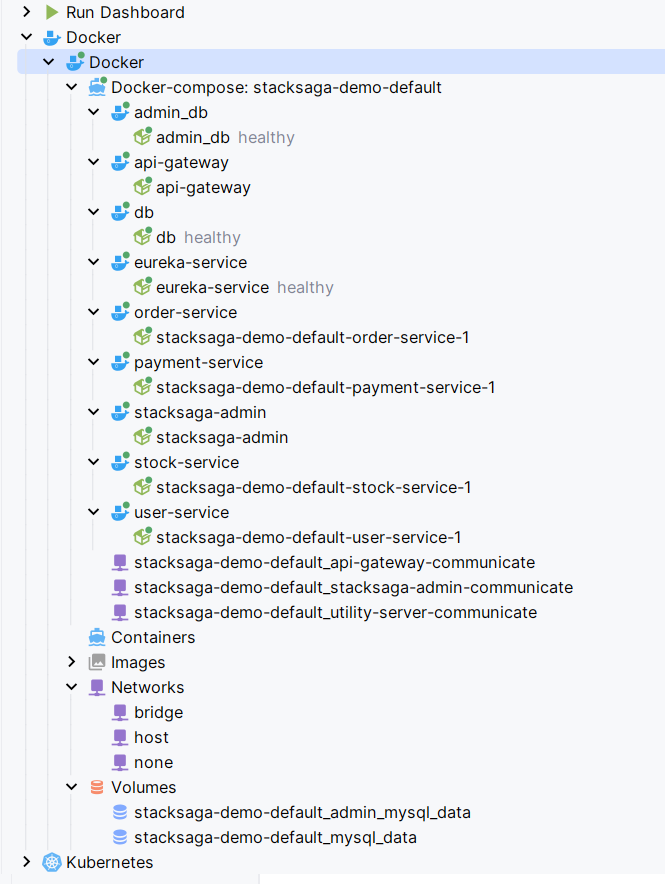Migrate To Docker Environment.
Overview
This will guide you to deploy your entire demo system in docker environment by creating docker images step by step.
| We only focus on the configuration files and manifest files for docker deployment and how the communication is happened in the docker environment. Please find the full source code here. |

The steps are as follows.
-
[Set up StackSaga-Admin server].
-
Updating
api-gatewayservice. -
Updating
eureka-serviceservice. -
Updating
order-serviceservice. -
Updating
user-serviceservice. -
Updating
stock-serviceservice. -
Updating
payment-serviceservice.
Set up StackSaga-Admin server in Docker.
Instead of running the executable jar fil in the local, you can use the StackSaga-Admin-Server image called stacksaga/stacksaga_admin_mysql from the docker-hub.
Let’s create the docker-compose file for running the StackSaga-Admin-Server and configure the database for the StackSaga-Admin-Server.
|
we create 3 different network groups in this example for grouping the services based on the communication. |
-
stacksaga-admin-communicategroup-
admin_dbservice. (from docker-compose.admin.yaml) -
stacksaga-adminservice. (from docker-compose.admin.yaml) -
order-serviceservice. (from docker-compose.services.yaml)
-
-
api-gateway-communicategroup-
api-gatewayservice. (from docker-compose.services.yaml) -
payment-serviceservice. (from docker-compose.services.yaml) -
user-serviceservice. (from docker-compose.services.yaml) -
order-serviceservice. (from docker-compose.services.yaml)
-
-
utility-server-communicategroup-
dbservice. (from docker-compose.services.yaml) -
eureka-serviceservice. (from docker-compose.services.yaml) -
api-gatewayservice. (from docker-compose.services.yaml) -
order-serviceservice. (from docker-compose.services.yaml) -
user-serviceservice. (from docker-compose.services.yaml) -
payment-serviceservice. (from docker-compose.services.yaml)
-
version: '3.8'
services:
admin_db: (1)
container_name: admin_db
image: mysql:8.0 (2)
restart: always
environment: (3)
MYSQL_ROOT_PASSWORD: mafei
MYSQL_USER: mafei
MYSQL_PASSWORD: mafei
ports:
- "3506:3306" (4)
volumes:
- admin_mysql_data:/var/lib/mysql (5)
healthcheck: (6)
test: [ "CMD", "mysqladmin" ,"ping", "-h", "localhost" ]
timeout: 20s
retries: 10
networks:
- stacksaga_admin (7)
stacksaga-admin: (8)
container_name: stacksaga-admin
image: stacksaga/stacksaga_admin_mysql:1.0.0 (9)
restart: always
ports:
- "4444:4444" (10)
environment: (11)
- SPRING_DATASOURCE_URL=jdbc:mysql://admin_db:3306/stacksaga_admin?createDatabaseIfNotExist=true
- SPRING_DATASOURCE_USERNAME=root
- SPRING_DATASOURCE_PASSWORD=mafei
depends_on:
admin_db:
condition: service_healthy (12)
networks:
- stacksaga_admin (13)
volumes:
admin_mysql_data: (14)
driver: local
networks:
stacksaga_admin: (15)
driver: bridgeHighlights
| 1 | Create a service for the database called admin_db. |
| 2 | Mysql version 8 is used as the image. This is the minimum version that supports StackSaga framework) |
| 3 | Pass the initial username and password for creating the database server. |
| 4 | Due to you many have run the local mysql the internal port exports in port 3506 for out of the docker environment. |
| 5 | Use the volume admin_mysql_data that we created for saving the mysql-image’s data in the allocated disk. |
| 6 | The StackSaga-Admin-Server should use the database that we are creating.
Therefore, we have to confirm that the stacksaga-admin server run after successfully starting the admin_db.
The command tha we have mentioned in the test will be called until it returns a success response. |
| 7 | admin_db server has been added to the stacksaga_admin group. because the database and the stacksaga-admin should communicate via the host. |
| 8 | creating the stacksaga-admin service for deploying the stacksaga_admin_mysql image. |
| 9 | The stacksaga/stacksaga_admin_mysql:1.0.0 is used for running the admin-server. |
| 10 | The port of the admin-server container is exposed to the outside with port 4444.
Then you can access the admin-dashboard via localhost:4444. |
| 11 | Passing the required configurations as environment variables. The database host and username and password of the database that we created above for the admin-server is added here. |
| 12 | Avoid running the admin-server before starting the mysql server successfully. |
| 13 | Add the stacksaga-admin server into the stacksaga_admin network group. |
| 14 | Creating the volume for storing the mysql database data in the allocated disk named admin_mysql_data. |
| 15 | Creating the network group that we used above named stacksaga_admin. |
eureka:
client:
serviceUrl:
defaultZone: http://eureka-service:8085/eureka/
instance:
instance-id: ${spring.application.name}:${random.uuid}
prefer-ip-address: true
server:
port: 8080
management:
info:
env:
enabled: true
endpoints:
web:
exposure:
include: "*"
info:
app:
author: mafei
name: ${spring.application.name}
version: 1.0.0
spring:
application:
name: api-gateway
cloud:
gateway:
globalcors:
cors-configurations:
'[/*/stacksaga/**]':
allowedOrigins:
- "http://localhost:4444"
allowedMethods: "*"
allowedHeaders: "*"
default-filters:
- DedupeResponseHeader=Access-Control-Allow-Credentials Access-Control-Allow-Origin
discovery:
locator:
lower-case-service-id: true
enabled: trueeureka:
client:
registerWithEureka: false
fetchRegistry: false
server:
port: 8085
management:
info:
env:
enabled: true
endpoints:
web:
exposure:
include: "*"
info:
app:
author: mafei
name: ${spring.application.name}
version: 1.0.0services:
payment-service: http://payment-service
stock-service: http://stock-service
user-service: http://user-service
server:
port: 8080
eureka:
client:
serviceUrl:
defaultZone: http://eureka-service:8085/eureka/
instance:
instance-id: ${spring.application.name}:${random.uuid}
prefer-ip-address: true
spring:
application:
name: order-service
datasource:
username: root
password: mafei
driver-class-name: com.mysql.cj.jdbc.Driver
url: jdbc:mysql://db:3306/stacksaga_place_order_demo_order_service?createDatabaseIfNotExist=true
liquibase:
enabled: false
stacksaga:
component-scan: org.example.aggregator
app-release-version: 1.0.0
connect:
admin-urls:
- http://stacksaga-admin:4444
admin-username: order-service-application-user
admin-password: ykLO89Irx2Q6Cf2j
datasource:
mysql:
jdbc-url: jdbc:mysql://db:3306/order-service?createDatabaseIfNotExist=true
username: root
password: mafei
driver-class-name: com.mysql.cj.jdbc.Driver
enable: true
cloud:
validate-internal-communication-on-start-up: false
management:
endpoint:
env:
enabled: true
endpoints:
web:
exposure:
include: "*"
info:
app:
author: mafei
name: ${spring.application.name}
version: ${stacksaga.app-release-version}
logging:
level:
org:
stacksaga: debugserver:
port: 8080
spring:
application:
name: payment-service
datasource:
username: root
password: mafei
driver-class-name: com.mysql.cj.jdbc.Driver
url: jdbc:mysql://db:3306/stacksaga_place_order_demo_payment_service?createDatabaseIfNotExist=true
jpa:
hibernate:
ddl-auto: update
eureka:
client:
service-url:
defaultZone: http://eureka-service:8085/eureka/
instance:
instance-id: ${spring.application.name}:${random.uuid}
prefer-ip-address: true
management:
endpoint:
env:
enabled: true
endpoints:
web:
exposure:
include: "*"
info:
app:
author: mafei
name: ${spring.application.name}
version: 1.0.0
logging:
level:
org:
stacksaga: debug
springframework: debug
root: infoserver:
port: 8080
spring:
application:
name: stock-service
datasource:
username: root
password: mafei
driver-class-name: com.mysql.cj.jdbc.Driver
url: jdbc:mysql://db:3306/stacksaga_place_order_demo_stock_service?createDatabaseIfNotExist=true
jpa:
hibernate:
ddl-auto: update
eureka:
client:
service-url:
defaultZone: http://eureka-service:8085/eureka/
instance:
instance-id: ${spring.application.name}:${random.uuid}
prefer-ip-address: true
management:
endpoint:
env:
enabled: true
endpoints:
web:
exposure:
include: "*"
info:
app:
author: mafei
name: ${spring.application.name}
version: 1.0.0
logging:
level:
org:
stacksaga: debug
springframework: debug
root: infoserver:
port: 8080
spring:
application:
name: user-service
datasource:
username: root
password: mafei
driver-class-name: com.mysql.cj.jdbc.Driver
url: jdbc:mysql://db:3306/stacksaga_place_order_demo_user_service?createDatabaseIfNotExist=true
jpa:
hibernate:
ddl-auto: update
eureka:
client:
service-url:
defaultZone: http://eureka-service:8085/eureka/
instance:
instance-id: ${spring.application.name}:${random.uuid}
prefer-ip-address: true
management:
endpoint:
env:
enabled: true
endpoints:
web:
exposure:
include: "*"
info:
app:
author: mafei
name: ${spring.application.name}
version: 1.0.0
logging:
level:
org:
stacksaga: debug
springframework: debug
root: info